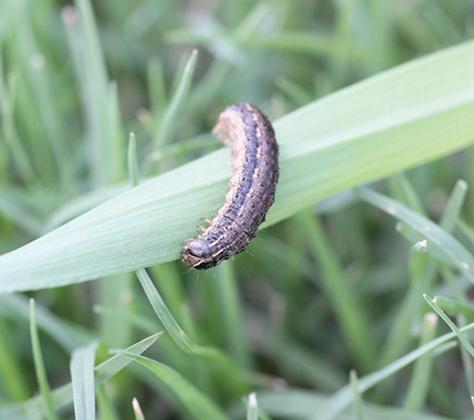Watch for Fall Armyworms in pastures
With our current temperatures and anticipated rain, forage producers need to be scouting for Fall Armyworms infestations in their fields.
The Fall Armyworm, Spodoptera frugiperda, is a common pest of bermudagrass, sorghum, corn, wheat and rye grass and many other crops in north and central Texas. Larvae of fall armyworms are green, brown or black with white to yellowish lines running from head to tail. A distinct white line between the eyes forms an inverted “Y” pattern on the face. Four black spots aligned in a square on the top of the segment near the back end of the caterpillar are also characteristic of fall armyworm. Armyworms are very small (1/8 inch) at first, cause little plant damage and as a result infestations often go unnoticed.
Larvae feed for 2-3 weeks and full-grown larvae are about 1 to 1 1/2 inches long. Given their immense appetite, great numbers, and marching ability, fall armyworms can damage entire fields or pastures in a few days.
Once the armyworm larva completes feeding, it tunnels into the soil to a depth of about an inch and enters the pupal stage. The armyworm moth emerges from the pupa in about ten days and repeats the life cycle. The fall armyworm moth has a wingspan of about 1 1/2 inches. Moths are active at night when they feed on nectar and deposit egg masses. A single female can deposit up to 2000 eggs and there are four to five generations per year.
Fall armyworm outbreaks in pastures and hay fields often occur following a rain which creates favorable conditions for eggs and small larvae to survive in large numbers. Hay fields with a dense canopy and vigorous plant growth are often more susceptible to armyworm infestations than less intensely fertilized and managed fields.
Look for fall armyworm larvae feeding in the crop canopy during the late evening and early morning and during cool, cloudy weather. During hot days, look for armyworms low in the canopy or even on the soil surface where they hide under loose soil and fallen leaves.
The key to managing fall armyworms is frequent inspection of fields to detect fall armyworm infestations before they have caused economic damage. Once larvae are greater than ¾ inch long, the quantity of foliage they eat increases dramatically. During their final 2-3 days of feeding, armyworms consume 80% of the total foliage consumed during their entire development.
The density of armyworms sufficient to justify insecticide treatment depends on the stage of crop growth and value of the crop. Seedling plants can tolerate fewer armyworms than established plants. Infestations of more than 2-3 armyworms (1/2 inch or longer) per square foot may justify an insecticide application. If practical, apply insecticides early in the morning or late in the evening when armyworm larvae are most active and therefor most likely to come into contact with the insecticide spray. If the field is near harvest, an early harvest, rather than an insecticide treatment, is an option.
For further information, contact Mark Arnold, County Extension Agent-Agriculture/Natural Resources, 701 South I-35 E, Waxahachie, or call 972/825-5175 or email: wmarnold@ag.tamu.edu

